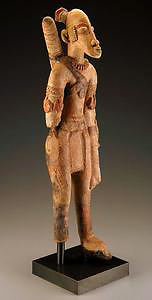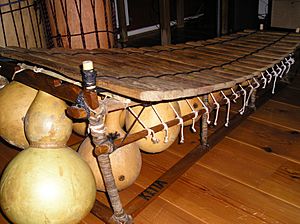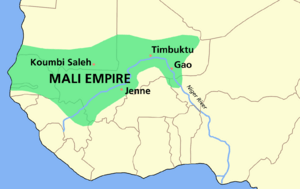Sundiata Keita facts for kids
Quick facts for kids Mansa Sundiata Keita |
|||||
|---|---|---|---|---|---|
| Founder and Emperor of Imperial Mali | |||||
| Reign | c. 1235 – c. 1255 | ||||
| Coronation | Crowned Mansa after The Battle of Kirina: c. 1235 | ||||
| Predecessor | Naré Maghann Konaté and Dankaran Touman both as Faamas (Kings in Mandinka language – pre-Imperial Mali. As a Mansa (King of Kings), preceded by none). | ||||
| Heir-apparent | Mansa Uli I | ||||
| Born | c. 1217 Dakadjalan, part of present-day Mali |
||||
| Died | c. 1255 (aged c. 37–38) | ||||
| Issue | Mansa Wali Keita Mansa Ouati Keita Mansa Khalifa Keita Mansa Sundiata Keita also had daughters not just sons. |
||||
|
|||||
| House | The Royal House of Keita | ||||
| Father | Naré Maghann Konaté | ||||
| Mother | Sukulung Conté | ||||
| Religion | Prevailing view: Traditional African religion others claim Muslim | ||||
Sundiata Keita (born around 1217, died around 1255) was a brave prince and the person who started the powerful Mali Empire. He is also known as the "Lion of Mali." He was the great-uncle of Mansa Musa, who is famous for being one of the richest people in history.
Stories about Sundiata were first told by griots, who are special storytellers in West Africa. Later, travelers like Muhammad ibn Battúta and ibn Khaldun wrote about him. These writings help us know that Sundiata was a real person. His life story is mainly known through the famous Epic of Sundiata, a long poem passed down through generations.
Contents
The Epic Story of Sundiata
The amazing stories about Sundiata Keita were told by griots for many years before they were written down. Sundiata was the son of King Naré Maghann Konaté and Queen Sogolon Condé. From a young age, Sundiata had trouble walking. His mother, Sogolon, was often made fun of because of his disability.
This made Sundiata very determined. He worked hard every day to gain strength. One day, he miraculously stood up and walked! He soon became a leader among his friends.
After his father, King Naré Maghann, died, Sundiata's half-brother, Dankaran Touman, and his mother, Sassouma Bereté, were very unkind to Sundiata and his mother. To keep Sundiata safe, Sogolon took her children and left their home. They traveled to different lands, including the Ghana Empire, and finally found safety in a place called Mema. The king of Mema admired Sundiata's courage and gave him an important job in his kingdom.
Later, a powerful king named Soumaoro Kanté from the Sosso kingdom conquered the Mandinka people. Messengers were sent to find Sundiata because an old prophecy said he would be a great leader. Sundiata agreed to return and free his people. The King of Mema even gave him an army to help.
Sundiata joined forces with other brave leaders from Mali. They made a promise to free their country from King Soumaoro. At the famous Battle of Kirina, Sundiata and his allies defeated King Soumaoro. After this great victory, Sundiata became the first Emperor of the Mali Empire. He was the first Mandinka king to use the special title Mansa, which means "king" or "emperor."
The epic poem about Sundiata doesn't give exact dates. But Arab writers who visited the area about 100 years later wrote down some details, including dates and family trees.
What Sundiata's Name Means
Sundiata had many names, like Sogolon Djata, Sundjata Keyita, and The Lion King. The name Sundiata comes from his mother's name, Sogolon, and the word Jata, which means "lion." So, Sundiata means "Sogolon's lion" or "the lion of Sogolon." This is a traditional way to praise someone in parts of West Africa.
The Battle of Kirina

Around 1235, Sundiata, who had survived earlier attacks by King Soumaoro, gathered his allies and went to war against him. King Soumaoro was a strong warrior, but Sundiata defeated him at the Battle of Kirina.
Soumaoro was known for following traditional African religions. He is also said to have invented the balafon, a type of wooden xylophone, and the dan, a four-string guitar.
After his victory, Sundiata took control of the lands Soumaoro had conquered. He also rewarded those who helped him defeat Soumaoro. Some of Soumaoro's allies were also defeated later. For example, a king from the Jolof kingdom was defeated by Tiramakhan Traore, one of Sundiata's generals. This happened after the Jolof king stole gold and horses that Sundiata had sent to buy.
Religion of Sundiata
Historians believe that Sundiata Keita followed traditional African religions. He was seen as a great hunter and a powerful leader. Most of his people also followed these traditional beliefs.
However, some of Sundiata's later rulers, like his great-nephew Mansa Musa, were Muslim. Some Muslim griots later added to Sundiata's story, trying to connect him to the prophet Muhammad. But historians say there is no proof of this in the original stories. These additions were likely made to link African history with Islam, which became very important in the region.
Building the Mali Empire
After his victory at Kirina, Mansa Sundiata made Niani his capital city. With the help of his skilled generals, especially Tiramakhan Traore, he conquered many other states. The lands of the old Ghana Empire became part of Mali. Tiramakhan also conquered areas in what is now Senegal, Gambia, and Guinea Bissau.
Even though Sundiata was called "Mansa" (emperor), he didn't rule alone. The Mali Empire was like a federation, where different tribes had their own leaders who represented them at the emperor's court. The most important Mandinka clans were the Traore, Kamara, Koroma, Konde, and Keita families.
The Great Gbara Assembly was a group that helped check the Mansa's power. They made sure his rules were followed and helped choose the next ruler, usually the Mansa's son or a close family member.
The Mali Empire became very rich and powerful from the 13th to the late 14th century. This was partly because Sundiata controlled important trade routes and gold mines.
Sundiata also helped develop Mali's farming. He is said to have brought cotton and weaving to the region. By the end of his rule, there was great peace and safety throughout his empire.
Death of Sundiata
Mansa Sundiata Keita likely died around 1255. There isn't much information about how he died, and different stories exist. Mandinka traditions also keep the burial places of their great kings secret.
Some stories say he drowned while trying to cross the Sankarani River near Niani. Today, there's a shrine there called Sundiata-dun, meaning "Sundiata's deep water." Other stories suggest he was accidentally killed by an arrow during a ceremony or even assassinated. However, drowning in the Sankarani River is the most commonly accepted story.
His three sons, Mansa Wali Keita, Mansa Ouati Keita, and Mansa Khalifa Keita, became emperors after him. The famous and very wealthy Mansa Musa was Sundiata Keita's great-nephew.
Sundiata's Legacy
Sundiata Keita left behind a strong legacy. His powerful army was a big reason for the Mali Empire's success. While Sundiata was a great leader, his generals, especially Tiramakhan Traore, also played a huge role in the conquests. Sundiata was able to inspire loyalty from his army and leaders.
Under Sundiata, Mali started to become a major economic power. He controlled important trade routes and gold fields, which his successors continued to build upon. The basic laws and rules of Mali, known as the Gbara and the Kouroukan Fouga, were first set up during his time. These rules were passed down orally and later influenced the laws of modern-day Mali.
Sundiata Keita was not just a conqueror. He also helped improve farming and introduced cotton and weaving to Mali. His rule brought a time of "absolute security" to his lands.
The story of Sundiata and the Mali Empire is taught in schools and universities around the world. Some scholars have even noticed similarities between the Epic of Sundiata and Walt Disney's 1994 animated film The Lion King.
- The 1995 film Keïta! l'Héritage du griot tells the legend of Sundiata Keita.
- The video game Age of Empires II HD: The African Kingdoms includes a campaign about Sundiata.
See also
 In Spanish: Sundiata Keita para niños
In Spanish: Sundiata Keita para niños
- History of Mali
- History of Senegal
- History of the Gambia
- Sosso people



